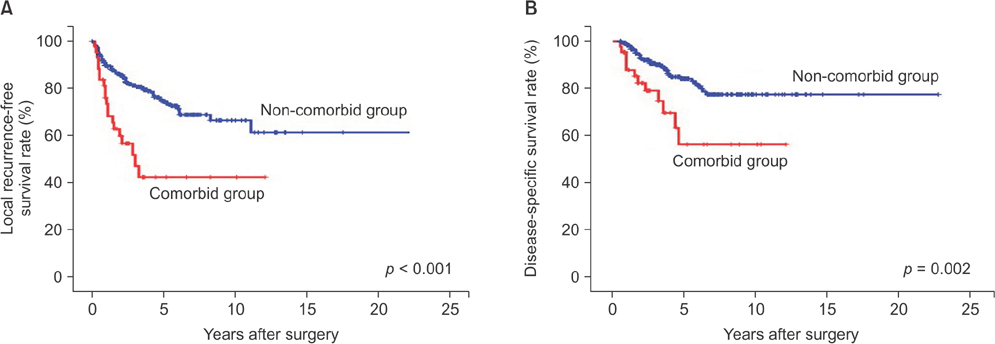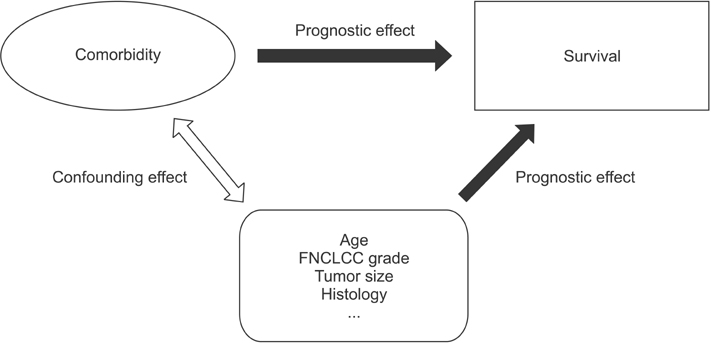Clin Orthop Surg.
2015 Mar;7(1):120-130. 10.4055/cios.2015.7.1.120.
Comorbidity is Independently Associated with Poor Outcome in Extremity Soft Tissue Sarcoma
- Affiliations
-
- 1Department of Orthopedic Surgery, Seoul National University Hospital, Seoul, Korea. hik19@snu.ac.kr
- 2Department of Medicine, Seoul National University College of Medicine, Seoul, Korea.
- KMID: 2069884
- DOI: http://doi.org/10.4055/cios.2015.7.1.120
Abstract
- BACKGROUND
Comorbidity has not been examined as an independent prognostic factor in soft tissue sarcoma (STS). We examined the prognostic impact of comorbidity on oncologic outcome in STS with an adjustment for possible confounding factors.
METHODS
A retrospective review was performed on 349 patients who had undergone surgery for high-grade localized STS of extremity at our institute. Conditions known to alter the risk of mortality, as defined in the Charlson comorbidity index, were classified as comorbidities and 43 patients (12%) had at least one comorbidity at the time of surgery. The association of comorbidity and oncologic outcomes of local recurrence-free survival (LRFS) and disease-specific survival (DSS) were tested with adjustment for confounding factors.
RESULTS
Comorbidity was associated with old age, high tumor grade, and large tumor size. The presence of comorbidity was independently associated with poor LRFS and DSS, even after adjusting for confounding factors including age and treatment variables.
CONCLUSIONS
Our data suggest that the presence of comorbidity is an independent prognostic factor for extremity STS.
Keyword
MeSH Terms
Figure
Cited by 1 articles
-
The age-adjusted Charlson comorbidity index as a predictor of survival in surgically treated vulvar cancer patients
Violante Di Donato, Zoe Page, Carlotta Bracchi, Federica Tomao, Angela Musella, Giorgia Perniola, Pierluigi Benedetti Panici
J Gynecol Oncol. 2019;30(1):. doi: 10.3802/jgo.2019.30.e6.
Reference
-
1. Lewis JJ, Brennan MF. Soft tissue sarcomas. Curr Probl Surg. 1996; 33(10):817–872.2. Ahn DH, Mehta N, Yorio JT, Xie Y, Yan J, Gerber DE. Influence of medical comorbidities on the presentation and outcomes of stage I-III non-small-cell lung cancer. Clin Lung Cancer. 2013; 14(6):644–650.3. Biau DJ, Ferguson PC, Turcotte RE, et al. Adverse effect of older age on the recurrence of soft tissue sarcoma of the extremities and trunk. J Clin Oncol. 2011; 29(30):4029–4035.4. Eilber FC, Rosen G, Nelson SD, et al. High-grade extremity soft tissue sarcomas: factors predictive of local recurrence and its effect on morbidity and mortality. Ann Surg. 2003; 237(2):218–226.5. Osaka S, Sugita H, Osaka E, Yoshida Y, Ryu J. Surgical management of malignant soft tissue tumours in patients aged 65 years or older. J Orthop Surg (Hong Kong). 2003; 11(1):28–33.6. Piccirillo JF, Tierney RM, Costas I, Grove L, Spitznagel EL Jr. Prognostic importance of comorbidity in a hospital-based cancer registry. JAMA. 2004; 291(20):2441–2447.7. Charlson ME, Pompei P, Ales KL, MacKenzie CR. A new method of classifying prognostic comorbidity in longitudinal studies: development and validation. J Chronic Dis. 1987; 40(5):373–383.8. Fritz AG, Percy C, Jack A, et al. International classification of diseases for oncology: ICD-O. 3rd ed. Geneva: World Health Organization;2000.9. Trojani M, Contesso G, Coindre JM, et al. Soft-tissue sarcomas of adults; study of pathological prognostic variables and definition of a histopathological grading system. Int J Cancer. 1984; 33(1):37–42.10. Zagars GK, Ballo MT, Pisters PW, et al. Prognostic factors for patients with localized soft-tissue sarcoma treated with conservation surgery and radiation therapy: an analysis of 1225 patients. Cancer. 2003; 97(10):2530–2543.11. Katz MH. Multivariable analysis: a practical guide for clinicians. 2nd ed. New York: Cambridge University Press;2006. p. 73–95.12. Asmis TR, Ding K, Seymour L, et al. Age and comorbidity as independent prognostic factors in the treatment of non small-cell lung cancer: a review of National Cancer Institute of Canada Clinical Trials Group trials. J Clin Oncol. 2008; 26(1):54–59.13. Kaplan MH, Feinstein AR. The importance of classifying initial co-morbidity in evaluating the outcome of diabetes mellitus. J Chronic Dis. 1974; 27(7-8):387–404.14. Italiano A, Mathoulin-Pelissier S, Cesne AL, et al. Trends in survival for patients with metastatic soft-tissue sarcoma. Cancer. 2011; 117(5):1049–1054.15. Blanco JA, Toste IS, Alvarez RF, Cuadrado GR, Gonzalvez AM, Martin IJ. Age, comorbidity, treatment decision and prognosis in lung cancer. Age Ageing. 2008; 37(6):715–718.16. Firat S, Pleister A, Byhardt RW, Gore E. Age is independent of comorbidity influencing patient selection for combined modality therapy for treatment of stage III nonsmall cell lung cancer (NSCLC). Am J Clin Oncol. 2006; 29(3):252–257.17. Pal SK, Hurria A. Impact of age, sex, and comorbidity on cancer therapy and disease progression. J Clin Oncol. 2010; 28(26):4086–4093.18. Farjah F, Wood DE, Varghese TK, Massarweh NN, Symons RG, Flum DR. Health care utilization among surgically treated Medicare beneficiaries with lung cancer. Ann Thorac Surg. 2009; 88(6):1749–1756.19. Lee L, Cheung WY, Atkinson E, Krzyzanowska MK. Impact of comorbidity on chemotherapy use and outcomes in solid tumors: a systematic review. J Clin Oncol. 2011; 29(1):106–117.20. Frasci G, Lorusso V, Panza N, et al. Gemcitabine plus vinorelbine versus vinorelbine alone in elderly patients with advanced non-small-cell lung cancer. J Clin Oncol. 2000; 18(13):2529–2536.21. Chen WW, Shao YY, Shau WY, et al. The impact of diabetes mellitus on prognosis of early breast cancer in Asia. Oncologist. 2012; 17(4):485–491.22. Liang JA, Sun LM, Yeh JJ, Sung FC, Chang SN, Kao CH. The association between malignancy and end-stage renal disease in Taiwan. Jpn J Clin Oncol. 2011; 41(6):752–757.23. Ooi LL, Zhou H, Kalak R, et al. Vitamin D deficiency promotes human breast cancer growth in a murine model of bone metastasis. Cancer Res. 2010; 70(5):1835–1844.24. Maisonneuve P, Agodoa L, Gellert R, et al. Cancer in patients on dialysis for end-stage renal disease: an international collaborative study. Lancet. 1999; 354(9173):93–99.
- Full Text Links
- Actions
-
Cited
- CITED
-
- Close
- Share
- Similar articles
-
- Infantile Extraosseous Ewing's Sarcoma in the Left Arm: A Case Report
- Update on the Management of Extremity Soft Tissue Sarcoma
- A Clinical Study of Soft Tissue Sarcoma in Orthopedic Surgery
- Alveolar soft-part sarcoma
- Reconstruction of Defect After Wide Excision of Malignant Soft Tissue Tumor of Limb Using Free Flap



